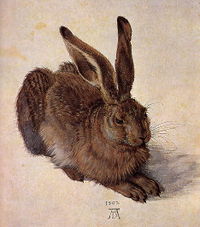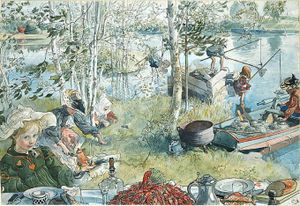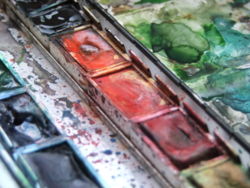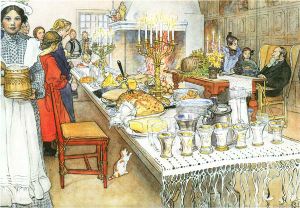Watercolor painting
2007 Schools Wikipedia Selection. Related subjects: Art
Watercolor (or watercolour, also known as aquarelle) is a painting technique using paint made of colorants suspended or dissolved in water. Although the grounds used in watercolor painting vary, the most common is paper. Others include papyrus, bark papers, plastics, vellum or leather, fabric, wood, and canvas.
History of watercolor painting

One early form of watercolor painting, that is not normally included in the category, is buon fresco painting — wall-painting using pigments in a water medium on wet plaster , which goes back to Egyptian and Roman antiquity. One well-known example of buon fresco is the Sistine Chapel by Michelangelo, begun in 1508 and completed in 1514.
Watercolour painting, usually referred to as brush painting in Asian contexts, has a long history in many parts of the world. In Chinese and Japanese painting it has been the dominant medium, often in monochrome black or brown, when it tends to be called ink. India, Ethiopia and other countries also have long traditions.
Watercolour has also been used for manuscript illumination since at least Egyptian times, and was a major part of European manuscript painting on vellum (often mixed with tempera). Paper spread from the Islamic world, via Islamic Spain, to Europe, where it was being manufactured in Germany and Italy before 1400. From the introduction of the old master print around 1400, most prints were coloured after printing until at least the latter part of the century, although the practice continued in some cases, such as English satirical prints , until the nineteenth century ( JMW Turner and Thomas Girtin were both employed at this as teenagers).
Watercolor painting was also used in cartoons and large paintings. In Germany, Albrecht Dürer ( 1471- 1528) painted watercolors, including the earliest pure landscape studies. An important school of watercolor painting in Germany was led by Hans Bol ( 1534- 1593) as part of the Dürer Renaissance.
Other famous artists have used watercolor painting, including Van Dyck, Claude, Giovanni Benedetto Castiglione, and many Dutch and Flemish artists, including several who worked in Britain, and originated the British school.
From the seventeenth century to the present, the British school of watercolour, which especially features landscape subjects, has been perhaps the most continuous and widely followed tradition in Europe. Among the most famous of the artists are: Alexander Cozens, William Gilpin, Thomas Gainsborough, Francis Towne, Paul Sandby, Thomas Girtin, John Sell Cotman, Samuel Palmer, William Blake, John Constable , JMW Turner, and Richard Parkes Bonnington.
The beginnings of the "California Style" of watercolor painting began in the 1920s and is described in California Watercolors 1850-1970. Milford Zornes is recognized as a leader in the California Style watercolor movement. His style differed from the traditional use of watercolors in which color was added to detailed pencil drawings. His work is characterized by the application of transparent washes of colour to large sheets of paper, allowing the white to show through and define shapes.
Watercolor paint
The broader term for water-based painting media is watermedia. The term watercolor most often to refers to traditional transparent watercolor or gouache (an opaque form of the same paint), but also includes the use of thinned acrylic paint.
Traditional watercolor paint is made of finely-ground pigment mixed with gum arabic for body, and glycerin or honey for viscosity and to bond the colorant to the painting surface. Unpigmented filler is added to gouache to lend opacity to the paint. Oil of clove is used to prevent mold.
Watercolor paints vary in their transparency, some being less transparent (more covering) than others. The more transparent paints allow the paper (or an undercolor) to show through while others allow less of the undercolor to be seen.
As there is no transparent white watercolor, the white parts of a watercolor painting are most often areas of the paper "reserved" (left unpainted) and allowed to be seen in the finished work. White paint might be used to indicate snow on a fence or the foam in the sea, as examples, by using Chinese White or White Gouache. These are not transparent. Traditionally, such non-transparent paint is used sparingly so as not to lose the light and airy look of the work.
Some watercolor pigments are "Fugitive", meaning they fade over time when exposed to light. An example is Alizarin Crimson. Some paint makers offer a different formulation of pigment as a less-fugitive alternative. These often have the word "Hue" as part of the name. "Alizarin Crimson Hue" can be expected to be less "Fugitive" than "Alizarin Crimson".
"Staining" is another characteristic of certain watercolor pigments. A Staining colour is difficult to remove and persists on the paper. Less staining colors can be lightened or removed almost entirely when wet or when re-wetted by "lifting" with a wet brush, paper towel, tissue, sponge, or similar.
Commercial watercolor paints come in two grades: "Artist" (or "Professional") and "Student". Artist quality paints are usually formulated using a single pigment, which results in richer colour and vibrant mixes. Student grade paints have less pigment, and often are formulated using two or more less expensive pigments. Artist and Professional paints are more expensive but many consider the quality worth the higher cost.
Paint pigments and formulation vary among manufacturers. Paints with the same colour name from different makers can vary in hue, staining, and other characteristics.
Techniques
Traditionally, watercolor paint is applied with brushes, but it may be applied with other implements in experimental approaches or mixed with other materials (usually acrylic or collage).
The paint is thinned before application to allow for lighter areas within the painting. This transparency provides watercolor its characteristics of brightness, sparkle, freshness, and clarity of colour since light has passed through the film of paint and is reflected back to the viewer through the film.
According to a tradition, dating from at least the early 20th century, the white of the paper is the only white used in transparent watercolor. Opaque paint is seldom used for whites or to overpaint.
Watercolor techniques have the reputation of being quite demanding; it is more accurate to say that watercolor techniques are unique to watercolor. Maintaining a high quality of value differences and colour clarity are typically the most difficult properties to achieve and maintain.
The medium is effective in portraiture, figurative art, and photorealism.
Watercolor proponents prize it as a studio medium for its lack of odour and ease of cleanup, and also as a plein air medium for its portability and quick drying.
Fingerpainting originated in China with watercolor paints.
Washes and Glazes
Basic watercolor technique involves washes and glazes. A wash refers to the application of a uniform color over an area of the painting. Typically this might be a light blue wash for the sky, a uniform color on a field or other area. Washes can be "graded" or "graduated" if they gradually become lighter or darker in parts such the fading of color to show the lighter sky near the horizon. A "variegated" wash blends more than one colour such as a wash with areas of blue and perhaps some red or orange for a sky at sunrise or sunset.
Painting "Wet-in-Wet"
Two methods of applying paint to the surface for special effect are "wet-in-wet" (or "wet-on-wet") and "dry brush". Wet-in-wet is used to avoid a hard edge at the margin of the paint. Wet-in-wet paint flows on a wet surface. The paint is wet (diluted) and the surface of the medium is wet.
The surface of the paper or other medium is first "painted" with water, thinned paint is then dripped or lightly applied to the wet surface. The colour flows along the wet area. More paint can be added to increase the area covered.
After the first wet application has dried, additional wet layers can be applied. The flow is controlled to some extent by the wetness of the surface; the amount, consistency, and placement of the paint; and by tilting the surface to encourage the paint to flow in the desired direction. The somewhat unpredictable results of the wet-in-wet technique can lead to some surprising but welcome affects.
Dry Brush
Dry Brush is used to obtain a rough, textured appearance for the edges of beach grass, a rocky exposed hill surface, tree bark, sunlight skipping on the surface of water, are some examples. A brush is loaded with relatively thick paint then lightly pulled over the dry surface of the medium. Some artists hold the brush with just two or three fingers at the very end of the handle so just the weight of the brush glides along the surface.
The paint adheres and covers only the higher points and ridges of the surface but stays out of the deeper areas. The method is especially effective on Rough and Cold Press (medium rough) paper. It is not very useful on smooth surfaces.
Painting Light-to-Dark
Watercolors are typically made darker on the paper by repeated application of the same color. These coats of paint are called "glazes. A glaze of a different color can also be used to create a combined color. It is also possible to achieve various lightness and darkness of a colour (value) by diluting the paint in the mixing area before application.
Limited Palette
An artist might use a limited set of colors in his or her palette creating other colors by mixing two or three colors from the limited set. Mixing more than three colors can result in a muddy, unacceptable colour.
The "Palette" refers to the array of colors used in a painting and also refers to the tray, dish, or other implement used to hold and mix the paints.
Other Considerations
When using watercolors it is a good idea to think of using the medium in the consistency as it comes from the tube. Using dried out "cake" watercolors will prevent the user from being able to take full advantage of the medium. When the colors are tube fresh one can go from totally thinned with water to create the most elusive effects and in an instant to very dense full bodied mixtures for deep dark passages. The best way to keep colors from drying out would be to use a covered palette such as the "John Pike Watercolor Palette" which has plenty of colors "wells" and sufficient mixing space. A great tip for squeezing paint from the tube is as follows: Squeeze an amount about the size of a lima bean or slightly larger. Don't leave the paint in a "mound" but rather spread it through the area of the designated color well. The logic behind this method is that since watercolors are resoluble with water, one can simply spray water on the surface of dried color to refresh it as it came from the tube. If the colors are left in a mound the water will roll off but if the colors are spread evenly the water has no place to go but into the color bringing it back to life. Do this twenty minutes or so before painting if your colors are dried out or if time does not allow just squeeze a little fresh color over the exsisting dried out color and spread. The new color will interact with the old making all the colour usable. Don't put a damp sponge in the palette for storage as this can lead to mildew and mold. The primary thing to remember is to take full advantage of the wide range of consistentcies watercolor has to offer.
Though there seem to be endless colors available in tubes, one need only a very limited palette. Consider a primary color palette to include: Lemon Yellow; Cadmium Yellow; Cadmium Red; Alizarin Crimson; Cerulean Blue; French Ultramarine Blue; Phtalo Blue; and perhaps Burnt Sienna and Raw Sienna. These nine colors will give you the ability to mix virtually any color possible. A brief summary of color mixing is: A red and a yellow make orange; yellow and blue make green; blue and red make violet. A red, yellow and blue make gray and if mixed dense enough, black. It's simple color theory of primary color mixing. Primary colors being: red - yellow - blue. Secondary colors (mixing any two colors): orange - green - violet. and Tertiary colors (three colour mixes): any gray imaginable and black. When mixing three colors avoid muddy mixtures by "undermixing" on the palette. Pull the colors into the mixing space and simply "swish" the colors together. Your darkest darks can be very exciting so long as you are sure to not "overmix." Another reason for muddiness comes from excessive brushing. Apply the washes with conviction being sure to limit your brushstrokes.
Equipment
Brushes for watercolor are made to hold water and softer as compared to the stiffer brushes used for acrylic and oil paint.
Watercolor brushes come in various shapes including flat, round, mop, and fan. There are numerous specialty brushes; for example, a long thin brush originally designed to paint the lines of rope (rigging) on a seascape is called a "Rigger".
Artists typically have a few favorites and do most work with just one or two brushes. A single brush can produce many lines and shapes. A "round" for example, can create thin and thick lines, wide or narrow strips, curves, and other painted effects. A flat brush when used on end can produce thin lines or dashes in addition to the wide swath typical with these brushes.
Brush hairs come from a variety of sources including the very expensive hair of the Kolinsky Sable, the ear hair of the Ox or other cattle, and others. "Camel" is used to describe hairs from several sources, none of which is from a camel.
Brush hairs can be natural, synthetic, or a combination. Brush prices vary considerably depending on the type of hair and the quality of the manufacture. A good brush will hold a fair amount of water and will keep and return to its original shape even after much use.
Brushes are numbered to indicate the size of the brush, the larger numbers for the larger brushes. A typical manufacturer's offering of brushes might go from a very small "0" to the larger size "20" or more. Flat, wide brushes are usually described by the width of the brush such as "1/2 inch" or "1 inch". There are no common standards for brush sizes. A "10" Round from two manufacturers might be slightly different in size.
Watercolor Paper is designed to properly support the paint and be sturdy enough to withstand the painting action. Painting on thin paper such as used for computer printers, for example, is possible but the paper will buckle (if not dissolve entirely), the paint will remain on the surface, running off in an uncontrolled manner.
The surface of watercolor paper can vary in its smoothness from very smooth to very rough. A watercolor painting on rough paper will result in quite a different look than a similar painting on smoother paper. The artist selects paper with a finish to give the desired effect.
Rough-surfaced paper is called "Rough", a smoother surface but still slightly rough is called "Cold Press" (aka "Not"), the smoothest surface is "Hot Press."
Watercolor paper is typically made of 100% cotton rag. Papers of lesser quality might be mixtures of rag (cotton) and other materials. Some artists use only better grade papers to get the effects they desire. The quality of paper can make a significant difference in the result.
The thickness of commercial watercolor paper varies from 90 pounds to 300 pounds (the weight of a ream of about 500 sheets of the paper.) A middle weight, common thickness, is 140 pound paper. While almost any paper of any thickness will buckle when wet, paper less than 140 pound thickness will buckle severely from the water and should be "stretched" before using. Even 140 pound paper will show some stress when wet watercolor is applied over large areas. 300 pound weight paper does not buckle severely and does not have to be stretched.
When using individual sheets one might consider "stretching" the paper to prevent severe moisture-based buckling of the paper. Using this method, the paper is soaked in a tub of cool water. The amount of time to soak will depend on the weight of the paper (fifteen minutes maximum for the heaviest sheet). Once the paper is at its full saturation, lay the sheet on a drawing board and use gummed tape or staples to secure the paper to the board. Be sure all air bubbles are pressed out before affixing to the board. Lay the board flat and let dry before the painting is begun. Any drawing can be done before the soaking. The term "stretching" is actually a little deceiving since the paper is in reality, "shrinking", tension applied to the paper as it dries, much like a drum head.
A watercolor "block" is a pad of paper bound on all four sides, which prevents buckling in a similar way as stretching. There are usually 20 sheets of paper in a block. After the top sheet is used, it is peeled off and the next sheet is exposed.
Besides commerical watercolor paper, arches paper is also commonly used and preferred.



